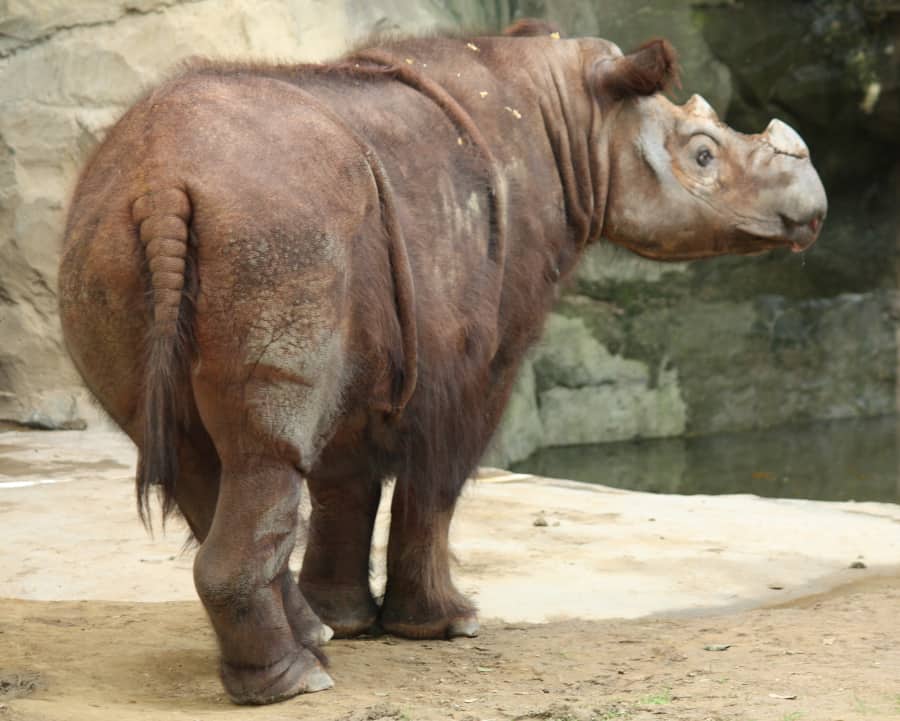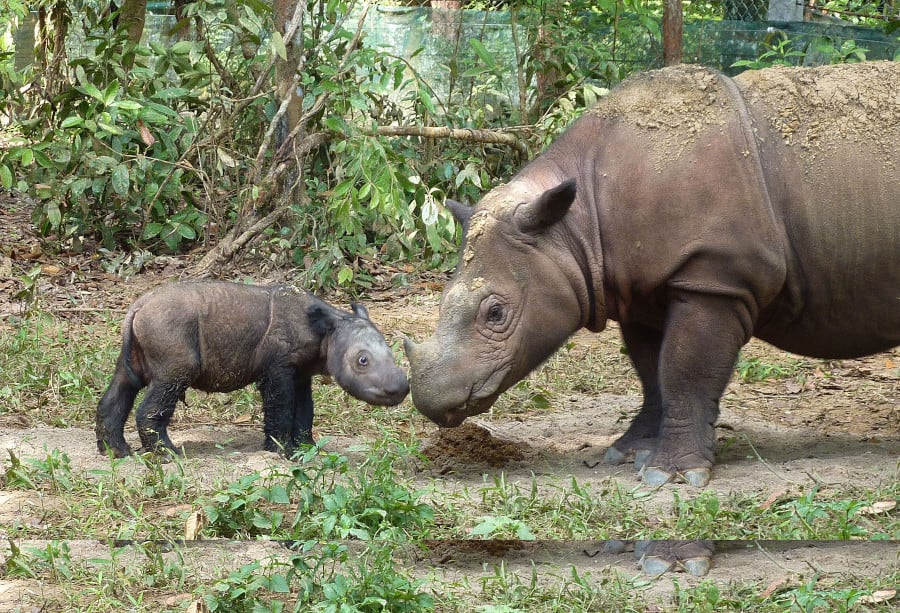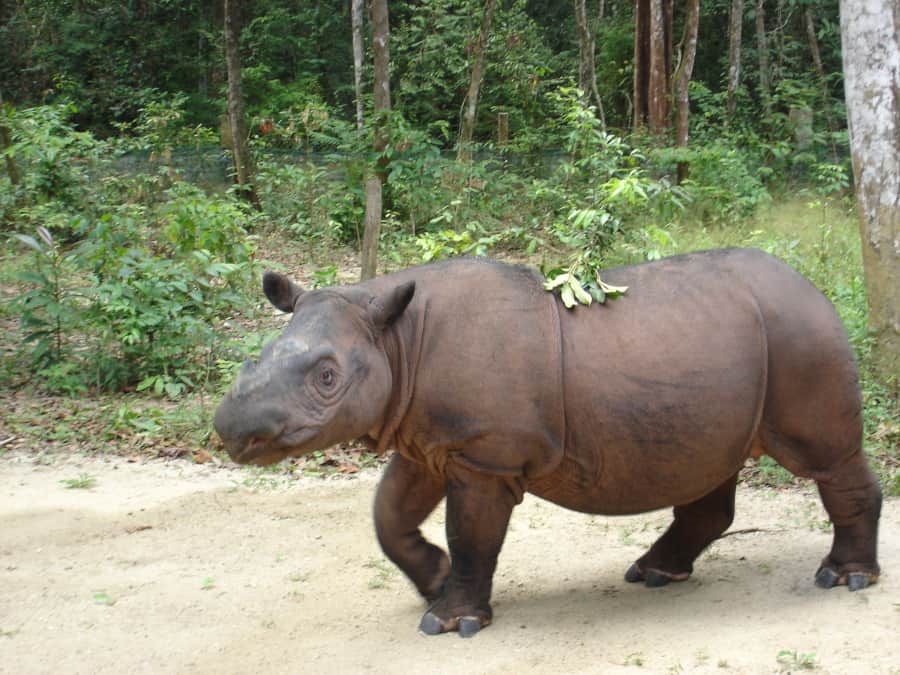*This post contains affiliate links. As an Amazon Associate, I earn from qualifying purchases. This means when you make a purchase, I get a commission at no cost to you! Read more about my affiliates on my Affiliate Links Disclaimer.
This is one mammal I won’t see in my travels throughout Malaysia and that we won’t get on camera traps. It’s a critically endangered species and has been extinct in the wild within Malaysia since 2015. The Sumatran rhinoceros (Dicerorhinus sumatrensis) is one of these most endangered large animals on earth. We often talk about the urgency in saving the black rhino, but by comparison, there are ~5,000 black rhinos. With only 80 individuals left*, saving the Sumatran rhinoceros will be a conservation challenge.
Learning about the smallest rhino in the world which is on the brink of extinction: the sumatran rhino #ICCB2019 #sumatranrhino pic.twitter.com/Cel7zvYVOu
— Ilke Geladi (@Ilke_Geladi) July 25, 2019
But I’m writing about the Sumatran rhinoceros not to make you sad, but to bring attention to this amazing species after a plenary** I attended at the International Congress for Conservation Biology conference. The plenary brought together leaders in conservation who have been working to save this amazing species. I believe that it is not too late and here I share with you what I learned from those saving the Sumatran rhinoceros.
What Makes the Sumatran Rhinoceros Such a Cool Animal
There are lots of reasons to love the Sumatran rhino. Margaret Kinnaird of the World Wildlife Foundation outlined several reasons why Sumatran rhinos are amazing animals. First, they are the most primitive of the existing rhino species. They are the only living species within a genus representing 20 million years of evolution. They are actually more closely related to the extinct woolly rhino of the Pleistocene epoch than our extant rhinos today!
Some other reasons have to do with their looks. They tend to be very hairy and have hair all over (which means added cuteness in my opinion), and they are also petite for a rhino (another element for enhanced cuteness!). Kinnaird explained that they are very talkative and have “wilting squeals and squeaks like singing dolphins.”

The Sumatran rhinoceros also has very odd reproductive behavior, which unfortunately has worked against it for conservation efforts. They are induced ovulators. Although they have a monthly cycle, they need a stimulus (a male that they like or as Kinnaird described it, “a good romp in the forest”) for them to ovulate.
Sumatran rhinos are endangered because of heavy poaching and habitat loss. They have poor thermoregulation and sleep during the day in mud wallows, which made them historically very easy for people to kill. With so few rhinos around, it will likely take a female rhino quite a long time to meet a male to get her to ovulate.
Saving the Sumatran Rhinoceros: Science to the (Partial) Rescue
Because there were so few individuals in the wild, rhinos were live-captured and put in captive breeding programs with hopes of producing baby rhinos to repopulate the species throughout their range. Unfortunately, captive breeding has proved to be challenging. Since 1984, a total of 45 Sumatran rhinoceros were taken from the wild and there were no captive births until 17 years later.

One of the reasons it took scientists so long to get a successful birth is because they didn’t know that the Sumatran rhinoceros had induced ovulation. Once they figured out their reproductive physiology, prospects improved, but still remained challenging.
Individuals that were captured were the easiest ones to capture and therefore not necessarily in the best condition to breed. One male had a snare wound on its leg and couldn’t mount females, while others had low sperm counts, digestive, and eye issues (of which the last two were likely from captivity and improved with time). Also, if individuals went too long without mating, they seemed to get reproductive tract problems, but no one really knows why. One female had five pregnancy losses before finally giving birth.
There have been five births in total and several of them by the same two pairs of rhinos. Even after those successes, for a species with so few individuals, maintaining genetic diversity will be critical to their survival and will be another challenge for captive breeding (i.e. ensuring that individuals that are genetically diverse from one another breed).
Finally, it also takes a long time to get a Sumatran rhino baby. Females have a 16 month gestation and then nurse their calves afterwards meaning that the Sumatran rhinoceros can at most have a calf every 3-3.5 years.


The biggest threat to the Sumatran rhinoceros though is politics. With 40 animals in captivity and different institutions and countries involved, everyone wanted to house a captive breeding facility. However, if you divide the rhinos by 10 facilities, you won’t have any one place that is good for captive breeding as there will be too few individuals at any given place. Also, there are many more males in captivity overall than females meaning that some facilities would not be functional.
One thing was clear from the panel: we need aggressive action to make saving the Sumatran rhinoceros possible. There is fear that that aggressive action could lead to individuals dying (for example, trying to bring vaquitas into captivity resulted in a death). However, if we don’t act at all or wait too long, we will definitely lose them.
Saving the Sumatran rhinoceros will depend on us. If you want to help you can donate to the Sumatran Rhino Rescue.
If you loved this post, read more about the Sumatran rhino’s ecology in Phillips’ Field Guide to the Mammalsof Borneo. I LOVE this field guide. Not only does it help you identify the mammals of Borneo, but about a third of it is devoted to helping you understand Borneo’s dynamic ecology.
*The IUCN Red List puts the estimate of Sumatran rhinos at 220-275, but the speakers at the presentation consistently said 80. 80 represents a more updated estimate.
**Plenary Panel Information: Saving Species on the Brink: Sumatran Rhino Rescue
Session description: Sumatran Rhino Rescue is a groundbreaking, collaborative effort to save a species from extinction. Bringing together the Government of Indonesia, some of the world’s top international conservation organizations, local experts and conservation practitioners, and supporters from around the world, the effort aims to save the Sumatran rhino from extinction by supporting search and rescue efforts to relocate rhinos in the wild and build conservation breeding facilities designed specifically for their care. Hear from the Sumatran Rhino Rescue team and key partners about how this unique model for conservation that blends government leadership, extensive technical expertise, and captivating storytelling can help save this unique species and be a model for future efforts to save species on the brink.
Moderator: Jeremy Hance, Senior Correspondent, Monga Bay
Panelists: John Payne, Executive Director, Borneo Rhino Alliance
Margaret Kinnaird, Global Wildlife Practice Leader, WWF International
Regional Panel Plenary – Saving Species on the Brink: Sumatran Rhino Rescue
Moderator: Jeremy Hance, Senior Correspondent, Monga Bay
Panelists: Jon Paul Rodriguez, Chair, IUCN Species Survival Commission
Terri Roth, Vice President of Conservation & Science and. Director of the Center for Conservation and Research of. Endangered Wildlife (CREW), Cincinnati Zoo & Botanical Garden
Rudi Putra, Director, Leuser Conservation Forum and National Geographic Fellow
Love this post? Share it with friends!



